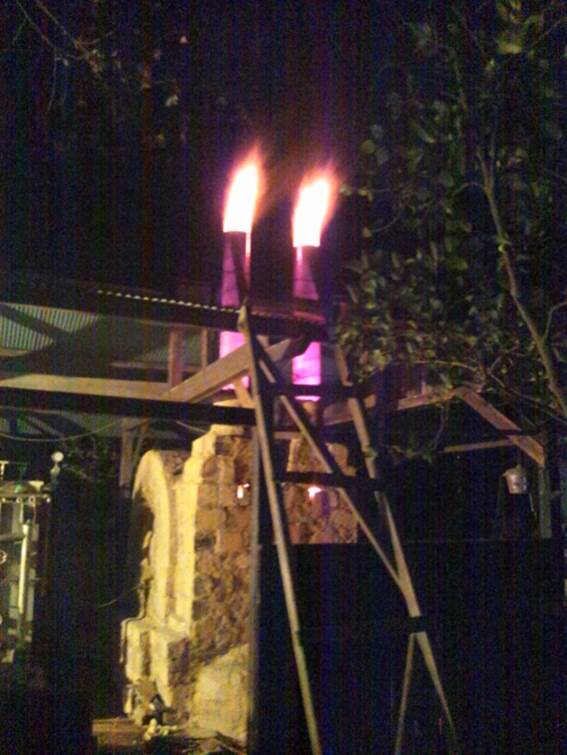Japanese Potteries(Explanations to the technical terms of ceramics No.21)
There are various technical words on potteries. Here are some of those, for which I'd like to give you some remarks.
Down-Draft Firewood Kiln No.2
This kiln has 2 flues. It’s said that nothing is different between having a flue that is very tall and 2 flues that are half in height. Though I don’t know if it’s because of the 2 flues, the temperature goes up easily. When exceeding 1200°C, flames blow out from the both flues wildly. Seeing the difference of flames between the right and the left, we can make a slight adjustment like “get 2 more pieces of firewood at the left side” or “just take it easy at the right side”. Though there’s a fire hole only, we could balance the flames by throwing more firewood to the left side.

Down-Draft Firewood Kiln
Just a little before the thermometer indicates the maximum temperature, we pick up some color samples from the kiln to determine the timing to stop firing checking how the glaze of those samples is melted. The glaze of samples shows different ways or speeds of melting depending on places located; the upper or the lower, or somewhere closer to the front firing area or the flues. For best results, it should not be melted too much. Too much melting may lose an interesting variety of potteries, so we’d better stop it just slightly before it goes too much. I think it is very difficult to judge that timing from those samples as big as a cup. In addition, there are works with many types of glaze in the kiln. It came to my mind that he had been very careful in deciding the arrangement of loading; where is the best to put each type of glaze. Thinking of the difference of temperature that may occur in the kiln, one with soluble glaze is brought to the lower place closer to the flues, otherwise to the upper place closer to the fireplace. While firing the kiln, a question comes up to my mind that how they control that they usually describe “burning kilns” or “burning clay”. I think that burning a kiln means burning off moisture it contains—in other words, making a coming temperature rise smooth by maturing in a lower range of temperature and exuding vapor first. Probably, an attempt to increase temperature suddenly without the process of burning a kiln may be resulted in failure hitting a certain limit when the rubber meets the road. This time he held more or less 1100°C for about 2 hours, which I think may be burning clay. Gradually burning clay, in which giving calories to works, may be for the purpose to prevent a half-baked result and to pull out a clay’s expression. Someone has ever told me that the Shino ware potters keep 1100°C as long as 10 hours. Even in this lower temperature, clay is burnt and glaze is to be slowly melted. It can be considered that keeping this temperature is to get rid of any temperature gaps in a kiln and to get ready for the next range of raised temperature to melt glaze. I could learn that it is not about just merely increasing temperature. As it was the first experience of firing and taking pots out of a downdraft kiln, I was exciting in helping him to remove pots. I put same pots in this kiln as those baked in the anagama, but some of them located in front of fireplace were surprisingly warped, as if very soft clay touched with fingers. Though it was firing for a day only, the works were well baked. I couldn’t even imagine that flames hit the works so strongly as to make them warped. As a whole, it was rather too much to be fired. The timing to stop fire was a little too slow and I realized how difficult it was. Because it is a firewood kiln, glaze starts to be melted from the side flames come to reach while being not perfectly melted in the other side. Kind of calm atmosphere of pots appears maybe because they have been cooled down slowly in the kiln. It seems that there was not much temperature difference between the upper side and lower in the kiln or it got higher temperature rather in the lower places. We assumed that flames didn’t reach the upper side well maybe because the flues worked too strongly. We have kept the draft of flues half-shut to gain higher pulling power though the draft was fully open in his previous attempts. Therefore, temperature itself could be easily raised but flames could not flow around in the kiln as we expected. Reflecting upon the failure, I promised that I will come help again in the next time and brought the fresh potteries home.
